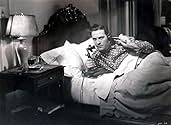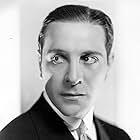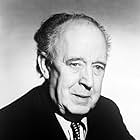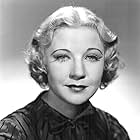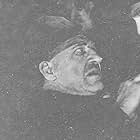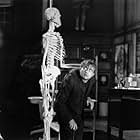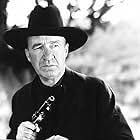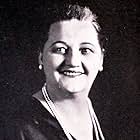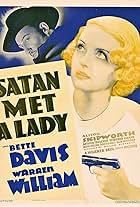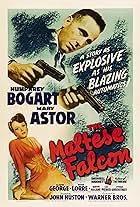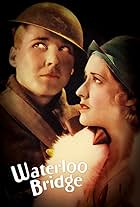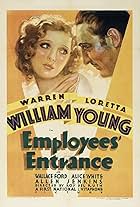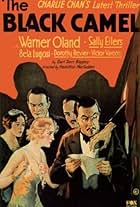IMDb RATING
6.8/10
3.4K
YOUR RATING
A lovely dame with dangerous lies employs the services of a private detective, who is quickly caught up in the mystery and intrigue of a statuette known as the Maltese Falcon.A lovely dame with dangerous lies employs the services of a private detective, who is quickly caught up in the mystery and intrigue of a statuette known as the Maltese Falcon.A lovely dame with dangerous lies employs the services of a private detective, who is quickly caught up in the mystery and intrigue of a statuette known as the Maltese Falcon.
Agostino Borgato
- Capt. John Jacobi
- (uncredited)
Tiny Jones
- Jailbird Seeking Cigarette
- (uncredited)
Cliff Saum
- Baggage Clerk
- (uncredited)
Morgan Wallace
- District Attorney
- (uncredited)
Lucille Ward
- Sarah - Prison Matron
- (uncredited)
Storyline
Did you know
- TriviaArt director Robert M. Haas performed the same function on The Maltese Falcon (1941).
- GoofsThe same prop is used for the suitcase that Spade finds in Miss Wonderly's room and the suitcase which contains the falcon. The travel stickers are identical on each one.
- Quotes
Effie Perrine: Sam, it's a gorgeous new customer.
Sam Spade: Gorgeous?
Effie Perrine: A knockout.
Sam Spade: Send her right in, honey.
Effie Perrine: [to the off-screen customer] Will you step in, please?
[Joel Cairo walks in.]
- ConnectionsFeatured in Great Performances: Bacall on Bogart (1988)
Featured review
Roy Del Ruth directed the original adaptation of the Dashiell Hammett novel in 1931, which starred Ricardo Cortez.
In a nutshell, THE MALTESE FALCON told the story about a San Francisco private detective named Sam Spade, who finds himself drawn into a search for a valuable falcon statuette first created during the Crusades, while investigating three murders.
The story began with a Miss Ruth Wonderly hiring Spade and his partner, Miles Archer, to find her missing sister and a man named Floyd Thursby. When Thursby and Archer end up murdered, Spade discovered that Miss Wonderly is one of three people searching for a statuette called the Maltese Falcon. A mortally wounded ship's captain delivered the statuette to Spade's office before dropping dead, making him the case's third murder victim. The entire case spiraled into a game of cat-and-mouse between Spade, Miss Wonderly, a wealthy fat Englishman named Caspar Gutman and an effeminate continental European named Dr. Joel Cairo. Spade also had to deal with the police, who are determined to pin the three deaths on him.
In the end, this version turned out better than I had expected. However, the movie is not without its faults. There were times when I felt I was watching a filmed play (very common with early talking movies). But the film's main problem seemed to be its pacing. It seemed too slow for what was supposed to be a witty murder mystery. Especially during the first half hour. By the time Joel Cairo was introduced into the story, the pacing finally began to pick up. The dialogue provided by screenwriters Maude Fulton, Brown Holmes and an unaccredited Lucien Hubbard failed to improve over the course of the movie. Not only did the screenplay allow the dialogue to drag throughout the entire film, the latter was not that memorable.
Considering that this is the only precode version of the film, it is not surprising that this version is considered the sexiest of the three filmed versions of the novel. Del Ruth, along with Fulton, Holmes and Hubbard, did an excellent job of conveying the womanizing aspect of Spade's character by revealing his affairs with Archer's wife Iva, his casual flirtation with his secretary Effie, and visual hints of his relationship with Ruth Wonderly like a small indent in the pillow next to the client's head, which hinted that Spade had spent the night with her. Other signs of precode sexuality included Spade bidding a female client good-bye at the beginning of the movie, a nude Miss Wonderly in a bathtub, and a hint of a homosexual relationship between Caspar Gutman and his young enforcer Wilmer Cook.
This version lacked the sharp wit of the 1941 adaptation. Considering that I have never read the novel, the screenplay did allow me to completely understand the story in full detail for the first time, without leaving me in a slight haze of fog. I found nothing memorable about William Rees' photography or Robert M. Haas' art direction except in one scene. The scene in question featured an exterior setting, namely a street in San Francisco's Chinatown where Miles Archer's body was discovered. I suspect that this particular scene gave both Rees and Haas an opportunity to display their artistry beyond the movie's usual interior settings.
There is also a solid cast here. Ricardo Cortez, led the cast as detective Sam Spade. Cortez gave a very sexy interpretation of Spade in his performance. His constant smirks and grins in the film's first ten to fifteen minutes seemed annoying. But in the end, Cortez grew on me. I can honestly say that not only did I find him very effective in portraying a sexy Sam Spade, he also managed to superbly capture the character's cynical humor, toughness and deep contempt toward the police.
Bebe Daniels, another survivor from the silent era, portrayed Ruth Wonderly, and this role has to be considered as one of her best. She managed to give an excellent performance as the ladylike yet manipulative woman who drew Spade into the labyrinth search for the Maltese Falcon. Mind you, she lacked Mary Astor's throbbing voice and nervous manner. But that is merely a minor hitch. Daniels still managed to portray a very convincing elegant temptress.
Irish-born Dudley Digges portrayed the wealthy and obsessive Caspar Gutman, who is not above murder, bribery and a score of other crimes to acquire the falcon statuette. Digges lacked the style to believably portray a man wealthy enough to conduct a twenty-year search for a valuable artifact. Instead, Digges reminded me of a corrupt minor official at a British post in the tropics. He seemed to lack talent and subtlety for infusing menace into his character. Whenever he tried to menacing, he only ended up giving a hammy performance. On the other hand, Otto Matieson gave a more believable performance as Dr. Joel Cairo, Gutman's Continental accomplice. Matieson portrayed Cairo as a no-nonsense and practical man who is careful with his money and with whom to trust it.
Una Merkel gave a humorous performance as Spade's Girl Friday, Effie. Her Effie is not hesitant about expressing her attraction to Spade, yet at the same time, she seemed to find the detective's other amorous activities rather amusing. Todd seemed to be trying too hard as a scorned lover without any subtlety. At least Dwight Frye fared better as Gutman's young enforcer, Wilmer Cook. He did a solid job in conveying the portrait of a baby-faced killer.
I'd suggest watching the 1931 version and the 1941 versions back to back, to get an idea of how Warner Brothers "grew up" during the 1930s. Remember they were just a poverty row studio mainly known for their Rin Tin Tin silent until The Jazz Singer made them rich.
In a nutshell, THE MALTESE FALCON told the story about a San Francisco private detective named Sam Spade, who finds himself drawn into a search for a valuable falcon statuette first created during the Crusades, while investigating three murders.
The story began with a Miss Ruth Wonderly hiring Spade and his partner, Miles Archer, to find her missing sister and a man named Floyd Thursby. When Thursby and Archer end up murdered, Spade discovered that Miss Wonderly is one of three people searching for a statuette called the Maltese Falcon. A mortally wounded ship's captain delivered the statuette to Spade's office before dropping dead, making him the case's third murder victim. The entire case spiraled into a game of cat-and-mouse between Spade, Miss Wonderly, a wealthy fat Englishman named Caspar Gutman and an effeminate continental European named Dr. Joel Cairo. Spade also had to deal with the police, who are determined to pin the three deaths on him.
In the end, this version turned out better than I had expected. However, the movie is not without its faults. There were times when I felt I was watching a filmed play (very common with early talking movies). But the film's main problem seemed to be its pacing. It seemed too slow for what was supposed to be a witty murder mystery. Especially during the first half hour. By the time Joel Cairo was introduced into the story, the pacing finally began to pick up. The dialogue provided by screenwriters Maude Fulton, Brown Holmes and an unaccredited Lucien Hubbard failed to improve over the course of the movie. Not only did the screenplay allow the dialogue to drag throughout the entire film, the latter was not that memorable.
Considering that this is the only precode version of the film, it is not surprising that this version is considered the sexiest of the three filmed versions of the novel. Del Ruth, along with Fulton, Holmes and Hubbard, did an excellent job of conveying the womanizing aspect of Spade's character by revealing his affairs with Archer's wife Iva, his casual flirtation with his secretary Effie, and visual hints of his relationship with Ruth Wonderly like a small indent in the pillow next to the client's head, which hinted that Spade had spent the night with her. Other signs of precode sexuality included Spade bidding a female client good-bye at the beginning of the movie, a nude Miss Wonderly in a bathtub, and a hint of a homosexual relationship between Caspar Gutman and his young enforcer Wilmer Cook.
This version lacked the sharp wit of the 1941 adaptation. Considering that I have never read the novel, the screenplay did allow me to completely understand the story in full detail for the first time, without leaving me in a slight haze of fog. I found nothing memorable about William Rees' photography or Robert M. Haas' art direction except in one scene. The scene in question featured an exterior setting, namely a street in San Francisco's Chinatown where Miles Archer's body was discovered. I suspect that this particular scene gave both Rees and Haas an opportunity to display their artistry beyond the movie's usual interior settings.
There is also a solid cast here. Ricardo Cortez, led the cast as detective Sam Spade. Cortez gave a very sexy interpretation of Spade in his performance. His constant smirks and grins in the film's first ten to fifteen minutes seemed annoying. But in the end, Cortez grew on me. I can honestly say that not only did I find him very effective in portraying a sexy Sam Spade, he also managed to superbly capture the character's cynical humor, toughness and deep contempt toward the police.
Bebe Daniels, another survivor from the silent era, portrayed Ruth Wonderly, and this role has to be considered as one of her best. She managed to give an excellent performance as the ladylike yet manipulative woman who drew Spade into the labyrinth search for the Maltese Falcon. Mind you, she lacked Mary Astor's throbbing voice and nervous manner. But that is merely a minor hitch. Daniels still managed to portray a very convincing elegant temptress.
Irish-born Dudley Digges portrayed the wealthy and obsessive Caspar Gutman, who is not above murder, bribery and a score of other crimes to acquire the falcon statuette. Digges lacked the style to believably portray a man wealthy enough to conduct a twenty-year search for a valuable artifact. Instead, Digges reminded me of a corrupt minor official at a British post in the tropics. He seemed to lack talent and subtlety for infusing menace into his character. Whenever he tried to menacing, he only ended up giving a hammy performance. On the other hand, Otto Matieson gave a more believable performance as Dr. Joel Cairo, Gutman's Continental accomplice. Matieson portrayed Cairo as a no-nonsense and practical man who is careful with his money and with whom to trust it.
Una Merkel gave a humorous performance as Spade's Girl Friday, Effie. Her Effie is not hesitant about expressing her attraction to Spade, yet at the same time, she seemed to find the detective's other amorous activities rather amusing. Todd seemed to be trying too hard as a scorned lover without any subtlety. At least Dwight Frye fared better as Gutman's young enforcer, Wilmer Cook. He did a solid job in conveying the portrait of a baby-faced killer.
I'd suggest watching the 1931 version and the 1941 versions back to back, to get an idea of how Warner Brothers "grew up" during the 1930s. Remember they were just a poverty row studio mainly known for their Rin Tin Tin silent until The Jazz Singer made them rich.
- How long is The Maltese Falcon?Powered by Alexa
Details
- Runtime1 hour 20 minutes
- Color
Contribute to this page
Suggest an edit or add missing content








